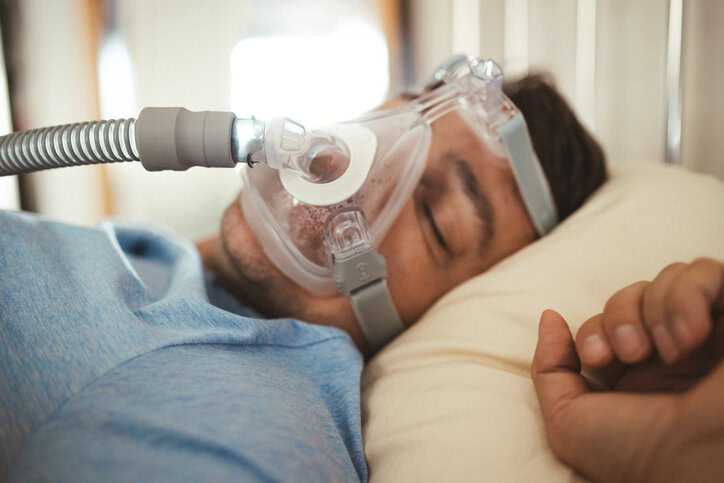Standards for Sleep Apnea: ISO 80601-2-70 and ISO 17510

Sleep apnea is more common than you may think. The National Sleep Foundation reported that sleep apnea likely affects as much as 20% of the population, and it has been found that around 85% of individuals with sleep apnea do not know they have it. In the United States alone about 30 million people have sleep apnea, but only 6 million are diagnosed with the condition.
What Is Sleep Apnea?
Sleep apnea is a common sleep disorder that causes frequent pauses in breathing during sleep, preventing restful sleeping. It is characterized by repeated episodes, called apneas, of breathing cessation or shallow breathing during sleep that can last from a few seconds to several minutes. There main types of sleep apnea are as follows:
- Obstructive sleep apnea (OSA), which is the more common form that occurs when throat muscles relax and block the flow of air into the lungs. According to the National Sleep Foundation, an estimated 30 million adults in the United States have obstructive sleep apnea (OSA), representing about 15% of the adult population.
- Central sleep apnea (CSA), which occurs when the brain does not send proper signals to the muscles that control breathing.
- Treatment-emergent central sleep apnea, also known as complex sleep apnea, which happens when someone has OSA—diagnosed with a sleep study—that converts to CSA when receiving therapy for OSA.
Most people with sleep apnea experience symptoms, such as loud snowing and daytime sleepiness. The sleep disorder can be a potentially serious with long-term health impacts, including risks for high blood pressure, heart attacks, metabolic syndrome, nonalcoholic fatty liver disease, stroke, and type 2 diabetes. Luckily, sleep apnea can be treated with lifestyle changes, medications, surgery, and devices.
Positive Airway Pressure (PAP) Therapy
Positive airway pressure (PAP) therapy is a treatment offered to nearly all people with obstructive sleep apnea (OSA). PAP therapy keeps the airway open with pressurized air that is pumped from a machine through a hose and a mask worn on the face. Their air pressure must be carefully calibrated in a process called titration that occurs during a sleep study.
PAP Therapy: Sleep Apnea Devices
A common type of PAP therapy uses a continuous positive airway pressure (CPAP) device that sends a stream of air always set to the same pressure level. A CPAP machine helps treat sleep apnea by delivering continuous air through the mouth and/or nose to help keep the airways open while sleeping. The CPAP is the most commonly prescribed device for treating sleep apnea disorders. Other types of breathing machines to treat sleep apnea include bi-level positive airway pressure (BiPAP) and auto-titrating positive airway pressure (APAP)—both of which provide variability in the amount of air pressure.
- CPAP device is programmed to produce pressurized air at one steady air pressure level. To change the air pressure, the user has to reset the device’s settings.
- APAP (automatic positive airflow pressure) machine checks the user’s breathing throughout the night. It automatically adjusts the air pressure to compensate for changes in the user’s sleep position or medications that may have changed the user’s breathing.
- BiPAP (Bi-level positive airflow pressure) has two pressure settings: one pressure for inhaling and another lower pressure for exhaling. It is used for individuals who cannot tolerate CPAP machines or have elevated carbon dioxide levels in their blood. BiPAP devices can also come with a backup respiratory rate for patients who have central sleep apnea—where the main concern is initiating breath.
International Standards for Sleep Apnea
The primary ISO standard related to sleep apnea is ISO 80601-2-70, which specifies the basic safety and essential performance requirements for “sleep apnea breathing therapy equipment,” meaning devices used to treat sleep apnea, like CPAP machines; while ISO 17510 focuses specifically on the masks and accessories used to connect this equipment to the patient.
- ISO 80601-2-70: Medical Electrical Equipment – Part 2-70: Particular Requirements for the Basic Safety and Essential Performance of Sleep Apnea Breathing Therapy Equipment sets safety and performance requirements for sleep apnea breathing therapy equipment used in homes and healthcare institutions. The standard is applicable to the basic safety and essential performance of sleep apnea breathing therapy equipment. It covers the functionality and safety aspects of sleep apnea treatment devices, including pressure delivery, alarms, and patient interface feature.
- ISO 17510: Medical devices – Sleep Apnea Breathing Therapy – Masks and Application Accessories specifies requirements for masks and accessories used with sleep apnea breathing therapy equipment. It applies to masks and their accessories used to connect a sleep apnea breathing therapy equipment to the patient. The standard specifies requirements for masks and accessories, including any connecting element, that are required to connect the patient-connection port of sleep apnea breathing therapy equipment to a patient for the application of sleep apnea breathing therapy (e.g., nasal masks, exhaust ports and headgear).
ISO 80601-2-70:2020—Medical electrical equipment – Part 2-70: Particular requirements for the basic safety and essential performance of sleep apnea breathing therapy equipment and ISO 17510:2015—Medical devices – Sleep apnea breathing therapy – Masks and application accessories are available on the ANSI Webstore.






